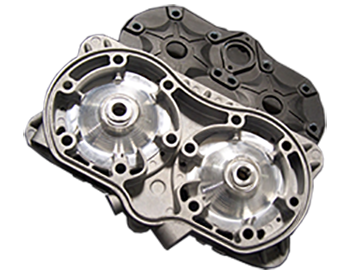 Generally, when you increase compression past a certain level, you need to increase the fuel octane requirement in order to combat detonation.
Detonation occurs when the cylinder pressure is high enough to ignite the end gases without the aid of the spark plug. This usually occurs in the combustion chamber end zones (near the bore edge of the dome).
Detonation is when the charge is prematurely combusted due to very high heat/pressure. This is more of an explosion than a combustion and the forces produced from this are VERY large and are super-sonic in nature.
The ignition of the end zone gases will create a shock wave that will amplify the current pressure waves and create a super high pressure which occurs at the "wrong" time with respect to the crank angle. This super high pressure will do damage to your engine.
So, think about it, if you increase the fuel's resistance to auto ignition by raising its octane level then it MAY not self ignite before the flame front reaches it.
So, what does this have to do with compression? It stands to reason that higher compression RATIOS will yield higher cylinder pressures (given that nothing else has changed before the compression ratio was raised) Well.. we just determined that the higher pressures are a major player in causing the fuel to auto ignite (not good) hence, the need for higher octane with higher compression RATIOS.
OK, we have been talking about compression ratios NOT cranking compression. What about the cylinder's cranking compression?
Continuing along the above lines:
What about cranking PSI vs Octane requirements?? My opinion is that they are not very closely related. In other words.. knowing what PSI your engine "cranks" out will NOT tell you whether or not you need a higher octane fuel, unless, of course, the PSI number is extremely large (like 200). Then, it may carry more weight and tell you , "yes", you do need some high octane fuel BUT it will NOT tell you which octane you need.
OK, "WHY?"
Let's do some deductive reasoning here:
Take an engine with an exhaust duration of 182 degrees ATDC and install some domes (any domes) that yield.. say 170 PSI cranking compression.
OK, take another engine, exactly the same, except the exhaust duration is at 198 degrees ATDC (ie higher exhaust port) Now, install the SAME domes that the other engines has. Now, the cranking compression reads only 150 PSI.
Hmmm.... so does this engine require a different octane of fuel than the other one? Probably, but not what you think.. It , most likely, requires, a HIGHER octane fuel NOT a lower octane.
I know that the general conception among riders is that the higher the PSI .. the higher the octane needed.. Well, I just told you completely the opposite.
With the general consensus.. it would stand to reason that when ever you raise the exhaust port... you need to run a lower octane fuel because the cranking compression will, indeed, get lower with higher exhaust heights. Does this seem right?? What if you lowered the exhaust height? Would you then need a higher octane fuel because the cranking PSI would surely go UP?
Let's look a few of the determining factors behind the above statements: Please realize that I will be over simplifying the processes but it should get the point across.
1: With an increase in exhaust height or area.. the probability of having more escaped fuel/air charge "stuffed" back into the cylinder just prior to exhaust port closing increases. This will raise your dynamic cylinder pressures and combustion temps.
2: Along those same lines... during the peak scavenging phase the larger exhaust CAN effectively pull more F/A charge in the cylinder and out the exhaust which then leads us back to #1.
3: Crown temps are higher with a raised exhaust. Anytime you have elevated crown temps, you increase your chances for detonation.
IMHO, there is no direct relation between cranking PSI and octane required. I wish there were.
For example.. one of my race engines (snowmobile) cranks only 140 PSI but I know that if I don't run at least 110 octane , the engine will not live for very long.
As we are beginning to realize... these PSI charts really give no relative information unless your engine is stock ported (and even then, I find that they are not useful)
This all relates to information needed when choosing a dome for your engine. I know that when you call up the head shop or go to the counter and ask the parts guy the conversation goes something like this:
YOU: "So, if I want to stay with premium pump gas, which size domes should I purchase?"
THEM: "Well, if you want to stay with premium fuel your cranking compression needs to stay below 160 PSI. These XXcc domes will put you right at that correct PSI for premium fuel"
I DO NOT AGREE WITH THIS LINE OF REASONING!
We see that the porting arrangement plays a MAJOR role in the resultant cranking compression. It is NOT only about the head!!!
Then.. You factor in the bore size in the equation and you REALLY can get into a pickle!!
So, you have to be very careful in choosing domes for your engine.
The head (dome) design itself, plays a large role in determining octane requirements of an engine. If the dome is not correct for the engine, you could be forced to run race fuel in order to avoid engine failure. OR on the other extreme, you may THINK your engine requires race fuel, when, in fact, it would live just fine on pump fuel. So, you could be throwing money and convenience right out the window.
|


